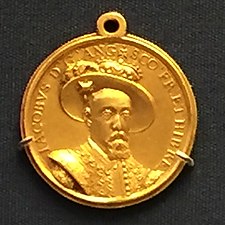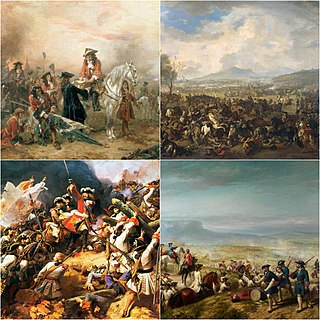
The War of the Spanish Succession was a European great power conflict fought between 1701 and 1714. The immediate cause was the death of the childless Charles II of Spain in November 1700, which led to a struggle for control of the Spanish Empire. His nominated heir was Philip of Anjou, a grandson of Louis XIV of France, whose main backers were France and most of Spain. His rival, Archduke Charles of Austria, was supported by the Grand Alliance, whose primary members included the Holy Roman Empire, the Dutch Republic, and Great Britain. Significant related conflicts include the 1700 to 1721 Great Northern War, and Queen Anne's War in North America.
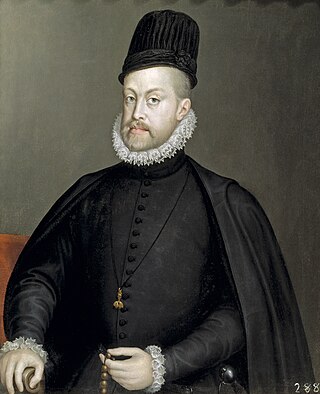
Philip II, also known as Philip the Prudent, was King of Spain from 1556, King of Portugal from 1580, and King of Naples and Sicily from 1554 until his death in 1598. He was also jure uxoris King of England and Ireland from his marriage to Queen Mary I in 1554 until her death in 1558. He was also Duke of Milan from 1540. From 1555, he was Lord of the Seventeen Provinces of the Netherlands.

Philip III was King of Spain. As Philip II, he was also King of Portugal, Naples, Sicily and Sardinia and Duke of Milan from 1598 until his death in 1621.
The Treaty of Dover, also known as the Secret Treaty of Dover, was a treaty between England and France signed at Dover on 1 June 1670. It required that Charles II of England would convert to the Roman Catholic Church at some future date and that he would assist Louis XIV with 60 warships and 4,000 soldiers to help in France's war of conquest against the Dutch Republic. In exchange, Charles would secretly receive a yearly pension of £230,000, as well as an extra sum of money when Charles informed the English people of his conversion, and France would send 6,000 French troops if there was ever a rebellion against Charles in England. The secret treaty was signed by the earl of Arlington, Baron Arundell, Baron Clifford, and Sir Richard Bellings for England and the marquis of Croissy for France. The two kings exchanged letters of ratification and kept secret the existence of the treaty. A public treaty of Dover was also negotiated, but it was a screen designed for propaganda purposes and to hide the religious dimension of the secret treaty. The Third Anglo-Dutch War was a direct consequence of this treaty. The actual treaty was published by historians a century later.

The Grand Alliance, sometimes erroneously referred to as its precursor the League of Augsburg, was formed on 20 December 1689. Signed by William III on behalf of the Dutch Republic and England, and Emperor Leopold I for the Habsburg Monarchy, its primary purpose was to oppose the expansionist policies of Louis XIV of France.

Albert VII was the ruling Archduke of Austria for a few months in 1619 and, jointly with his wife, Isabella Clara Eugenia, sovereign of the Habsburg Netherlands between 1598 and 1621. Prior to this, he had been a cardinal, Archbishop of Toledo, viceroy of Portugal and Governor General of the Habsburg Netherlands. He succeeded his brother Matthias as reigning archduke of Lower and Upper Austria, but abdicated in favor of Ferdinand II the same year, making it the shortest reign in Austrian history.
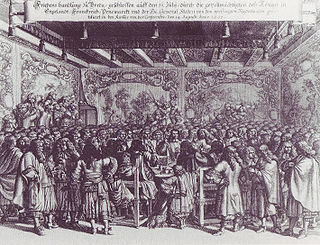
The Peace of Breda, or Treaty of Breda was signed in the Dutch city of Breda, on 31 July 1667. It consisted of three separate treaties between England and each of its opponents in the Second Anglo-Dutch War: the Dutch Republic, France, and Denmark–Norway. It also included a separate Anglo-Dutch commercial agreement.

The Anglo-Spanish War (1585–1604) was an intermittent conflict between the Habsburg Kingdom of Spain and the Kingdom of England that was never formally declared. It began with England's military expedition in 1585 to what was then the Spanish Netherlands under the command of the Earl of Leicester, in support of the Dutch rebellion against Spanish Habsburg rule.

Spanish Netherlands was the Habsburg Netherlands ruled by the Spanish branch of the Habsburgs from 1556 to 1714. They were a collection of States of the Holy Roman Empire in the Low Countries held in personal union by the Spanish Crown. This region comprised most of the modern states of Belgium and Luxembourg, as well as parts of northern France, the southern Netherlands, and western Germany with the capital being Brussels. The Army of Flanders was given the task of defending the territory.

The siege of Ostend was a three-year siege of the city of Ostend during the Eighty Years' War and the Anglo–Spanish War. A Spanish force under Archduke Albrecht besieged the fortress being held initially by a Dutch force which was reinforced by English troops under Francis Vere, who became the town's governor. It was said "the Spanish assailed the unassailable; the Dutch defended the indefensible." The commitment of both sides in the dispute over the only Dutch-ruled area in the province of Flanders, made the campaign continue for more than any other during the war. This resulted in one of the longest and bloodiest sieges in world history: more than 100,000 people were killed, wounded, or succumbed to disease during the siege.

The Twelve Years' Truce was a ceasefire during the Eighty Years' War between Spain and the Dutch Republic, agreed in Antwerp on 9 April 1609 and ended on 9 April 1621. While European powers like France began treating the Republic as a sovereign nation, the Spanish viewed it as a temporary measure forced on them by financial exhaustion and domestic issues and did not formally recognise Dutch independence until the Treaty of Westphalia in 1648. The Truce allowed Philip III of Spain to focus his resources elsewhere, while Archdukes Albert and Isabella used it to consolidate Habsburg rule and implement the Counter-Reformation in the Southern Netherlands.
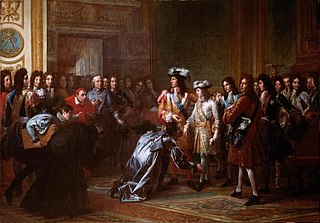
The Treaty of Den Haag, or Treaty of The Hague, was signed on 7 September 1701 between England, the Holy Roman Emperor Leopold I, and the United Provinces. It reconstituted the 1689 anti-French Grand Alliance in response to the issues that resulted in the War of the Spanish Succession.
Juan de Tassis y Acuña, 1st Count of Villamediana, was a Spanish diplomat and official, awarded his title by king Philip III of Spain in 1603, and the General Head of Spanish Post Offices.

Jean Grusset dict Richardot, knight was a statesman and diplomat from the Franche-Comté, who held high political office during the Dutch Revolt and played an important role in restoring Habsburg rule in the Southern Netherlands.

The siege of Amiens was a siege and battle fought during the Franco-Spanish War (1595–1598), as part of both the French Wars of Religion and the Anglo-Spanish War (1585–1604), between 13 May and 25 September 1597. The Spanish, who had sent a large army in March, had captured the city of Amiens easily in a ruse. Henry IV of France, after the surprise of the capture, immediately and quickly built up an army which included a large English force and besieged Amiens on 13 May.

The siege of Calais of 1596, also known as the Spanish conquest of Calais, took place at the strategic port-city of Calais, between 8 and 24 April 1596, as part of the Franco-Spanish War (1595–1598), in the context of the French Wars of Religion, the Anglo-Spanish War (1585–1604), and the Eighty Years' War. The siege ended when the city fell into Spanish hands after a short and intense siege by the Spanish Army of Flanders commanded by Archduke Albert of Austria, Governor-General of the Spanish Netherlands. The French troops in the citadel of Calais resisted for a few days more but finally, on 24 April, the Spanish troops led by Don Luis de Velasco y Velasco, Count of Salazar, assaulted and captured the fortress, achieving a complete victory. The Spanish success was the first action of the campaign of Archduke Albert of 1596.

The Somerset House Conference, 1604 is an oil-on-canvas painting depicting the Somerset House Conference held in 1604 to negotiate the end the Anglo-Spanish War. It is a group portrait, depicting the 11 representatives of the governments of England, Spain and the Spanish Netherlands, seated around a conference table, probably in old Somerset House.

The siege of Rees of 1599, also known as the relief of Rees, was an unsuccessful attempt by Protestant-German forces led by Count Simon VI of Lippe, and Anglo-Dutch forces sent by Prince Maurice of Nassau, commanded by Philip of Hohenlohe-Neuenstein and the Count Ernst of Solms, to capture the strategic stronghold of Rees, Lower Rhine, Duchy of Cleves from the Spanish forces of Don Francisco de Mendoza, Admiral of Aragon, second-in-command of the Army of Flanders, and Governor Don Ramiro de Guzmán, between 10–12 September 1599, during the Eighty Years' War and the Anglo-Spanish War (1585–1604). This Spanish victory was part of the campaign of Francisco de Mendoza and Cardinal Andrew of Austria of 1598-1599, also called the Spanish Winter of 1598-99.

The siege of Sluis (1604), also known as the Sluis campaign or the Battle of the Oostburg Line, was a series of military actions that took place during the Eighty Years' War and the Anglo–Spanish War from 19 May to 19 August 1604. A States and English army under Prince Maurice of Orange and Horace Vere respectively crossed the Scheldt estuary and advanced on land taking Cadzand, Aardenburg, and IJzendijke in the Spanish Netherlands. This soon led to the culmination of the siege of the Spanish-held inland port of Sluis.
The Cautionary Towns were three strategic Dutch towns which, under the 1585 Treaty of Nonsuch, were held by English troops as security for assistance provided by Elizabeth I during the Eighty Years' War against Spain. They included Brill (Brielle) in Holland and Flushing (Vlissingen) and Fort Rammekens on the nearby island of Walcheren. The bases were returned to the Dutch Republic in 1616.

